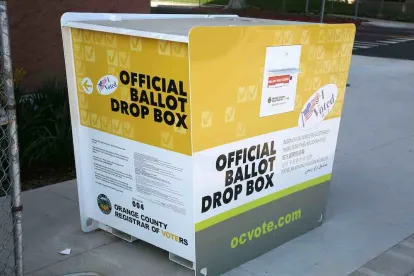Election 2020: Patience Required.
Voting in the 2020 elections wraps up in just four days, on November 3, 2020. However, due to many tight races and the unprecedented volume of mail-in ballots (and states’ differing rules on when those ballots can begin to be counted), it may be some time before we know which party will control the U.S. House of Representatives, the U.S. Senate, or the White House—or one or both houses of Congress and the White House—beginning in 2021. With everyone’s emotions already running high, this potential uncertainty means that next week may be a particularly challenging and nerve-racking one for employers and employees. To help relieve this anxiety, the U.S. Chamber of Commerce has provided a helpful fact sheet that reminds us that such delays are normal occurrences in our electoral system.
You Dirty Rat!
Gigantic inflatable rats might be great Halloween decorations, but is displaying them during labor protests a violation of the secondary boycott prohibitions contained in the National Labor Relations Act (NLRA)? This week, the National Labor Relations Board announced that it would accept amicus briefs in a case dealing with this very question. The debate is not new. Labor unions’ use of the inflatable rat display and other bannering tactics were given the green light in a pair of decisions issued by the Board during President Barack Obama’s first term. However, the dissenting Board members in those cases argued that the rat was a coercive and familiar symbol of labor unrest and that its use should have been considered unlawful secondary activity. The Board will determine whether its prior decisions impermissibly narrowed the type of activity covered by the NLRA’s secondary activity prohibitions. Amicus briefs are due on or before December 28, 2020.
Independent Contractor Comment Period Closes.
October 26, 2020, was the deadline for stakeholders to submit comments in response to the U.S. Department of Labor’s (DOL) proposed independent contractor regulations under the Fair Labor Standards Act. The proposal focuses on “economic dependence” as the “ultimate inquiry” when determining whether, “as a matter of economic reality,” a worker “is in business for him- or herself” (an independent contractor) or is dependent on another entity for work (an employee). The proposal also identifies two core factors that are the most probative in determining independent contractor status: (1) “the nature and degree of the worker’s control over the work” and (2) “the worker’s opportunity for profit or loss.” Among the groups filing comments was the National Retail Federation, which wrote:
The DOL’s proposed rule benefits all stakeholders, as it creates clear guidelines for when entrepreneurs are properly viewed and treated as independent contractors. It allows both them and their clients and business partners to have the confidence and certainty needed to thrive in a turbulent economy.
What happens next, like so many policy discussions these days, depends on the results of the election. If President Donald Trump wins, it will be full speed ahead to finalization (likely followed by litigation). If former vice president Joe Biden wins (and brings the Senate with him), things could get tricky. In this scenario, a Biden administration could put the brakes on a not-yet-finalized rule. If the current administration tried to finalize the rule on its way out, the Biden administration could rescind the rule using the Congressional Review Act (though doing so would severely limit Democrats’ ability to promulgate their own version of an independent contractor regulation). Stay tuned.
DOL on Press Releases.
One of the long-standing employment policy debates in Washington, D.C., centers on regulatory agencies’ use of the press as a regulatory tool. This is perhaps most common in the workplace safety arena, where the Obama-era Occupational Safety and Health Administration (OSHA) popularized a “regulation by shaming” campaign. This policy often resulted in the issuance of press releases that castigated employers and were conclusory in nature. In some cases, press releases would accuse employers of violations yet never correct the record when the accusations were later found to be without merit. The administration has curtailed this policy, but has not ended it completely. Recently, the DOL issued a memorandum to the heads of its sub-agencies (OSHA, the Wage and Hour Division, etc.) to provide guidance on enforcement-related press releases. The memorandum instructs agency heads that “[a]s a matter of Department policy, in general, enforcement agencies should not issue news releases before achieving a successful outcome.” Thus, the memo instructs that the appropriate times for press releases are following a settlement or conciliation agreement, a conviction or plea agreement, a decision by a court or other tribunal, and so forth.
DHS Proposes Scrapping H-1B Visa Lottery.
Another week, another effort by the administration to upend the existing H-1B guest worker program. On October 28, 2020, the U.S. Department of Homeland Security’s (DHS) U.S. Citizenship and Immigration Services (USCIS) announced a notice of proposed rulemaking (NPRM) to end the H-1B visa lottery by amending its regulations controlling the process by which H-1B cap-subject petitions are approved. Pursuant to the proposal, USCIS would prioritize selection of H-1B applicants with the highest promised salaries and work down from there. USCIS claims that this new selection criteria “would increase the average and median wage levels of H-1B beneficiaries who would be selected” and “would maximize H-1B cap allocations, so that they more likely would go to the best and brightest workers.” Like other recent immigration proposals, this one is also prone to legal challenge, particularly since DHS itself admitted in its 2019 H-1B preregistration regulation the following: “DHS believes, however, that prioritization of selection on other factors, such as salary, would require statutory changes.” The NPRM is scheduled to be published in the Federal Register on November 2, 2020, and comments are due 30 days later.
Tuesday Afternoon.
Why is this year’s Election Day on Tuesday, November 3, 2020, and why is the election always on a Tuesday in November? Way back when, states held elections whenever they pleased within about a 30-day window leading up to the beginning of December. But in 1845, Congress got everybody on the same page by passing a law designating the first Tuesday following the first Monday in November as Election Day. The nineteenth century agrarian economy of the United States explains why this time was chosen. Spring and summer voting would have interfered with planting and harvesting, and winter weather was too harsh. Additionally, many voters needed a two-day window to travel long distances to get to urban polling centers. Weekends were out due to religious observances, and Wednesday was a popular day for farmers markets. So a Tuesday in early November was chosen as the ideal time for Election Day.




 />i
/>i

